![]()
![]()
![]()
Use LEFT and RIGHT arrow keys to navigate between flashcards;
Use UP and DOWN arrow keys to flip the card;
H to show hint;
A reads text to speech;
262 Cards in this Set
- Front
- Back
|
pronunciation of consonant clusters |

Second consonant is often omitted in spoken Thai |
|
|
Placement of consonant clusters |

Only in word beginning |
|
|
Which consonant defines class of consonant cluster |
the first one |
|
|
two-syllable words with unwritten a: which tone of the first syllable |
medium |
|
|
two-syllable words with unwritten a: which tone of the second syllable |

the second consonant defines the tone of the syllable. or the first one if the second consonant is one of the consonants below
|
|
|
classes of two-syllable words with unwritten vowel |

1. with unwritten a 2. with unwritten o in some words starting from br. |
|
|
Words written with rising tones but pronounced with high tones: |
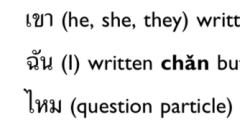
|
|
|
Words written with falling tones but pronounced with low tones: |

|
|
|
Words written with long vowels but pronounced with short vowels: |
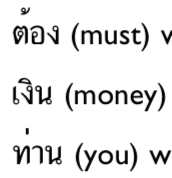
|
|
|
Words written with short vowels but pronounced with long vowels: |
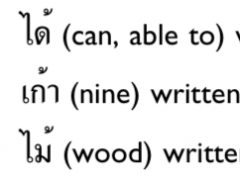
|
|
|
words with a linker syllable |

|
|

pronunciation |

hidden karan (the last consonant is omitted) |
|

pronunciation |

karan kill also the preceding consonant
|
|

pronunciation of some Indian words |
the last short vowel is not pronounced |
|

pronunciation |

pronounced as the low class s |
|

pronunciation |

r is not pronounced |
|

pronunciation |

ending r without vowel is pronounced as -oon |
|

pronunciation |
1. as -an at the end of a syllable 2. if there is a consonant at the end of syllable, then pronounced as a |
|

pronunciation |

r is not pronounced |
|

pronunciation |

Low-class consonant |
|
|
order of a place name |
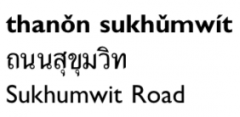
1. place type (e.g. street), then its name 2. the only exclusion is Chulalongkorn University |
|
|
how to indicate plural form of nouns? |
numbers or indefinite quantifier words, such as many, every, a few, can be used; a very small number of nouns may be reduplicated as a means of indicating plurality |
|
|
Which words are more formal: Thai origin or Indian origin? |
Indian origin |
|
|
Types of compound nouns |
1. HEAD NOUN + NOUN ATTRIBUTE (rót fay) 2. HEAD NOUN + VERB (+ OBJECT) ATTRIBUTE (khon khàp rót ) |
|

compound |
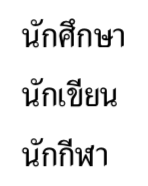
nák (‘one skilled in ...’) + VERB or NOUN |
|

compound |
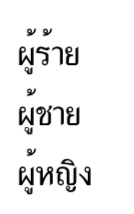
phûu (‘one who . . .’) + VERB (but note last two examples with noun) |
|

compound |
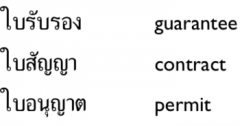
bay (‘a sheet of paper’) + VERB |
|

compound |
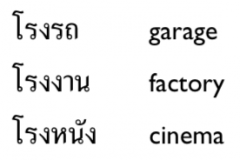
roong (‘a large building’) + NOUN or VERB |
|

compound |
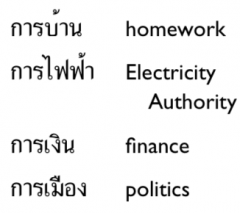
kaan (‘matters of ...’ ) + NOUN; kaan (‘act of ...’ ) + VERB
|
|

compound |

khwaam (used to form abstract nouns ) + VERB |
|

compound |

thîi (‘person whom one . . ., place where . . ., thing which . . .’) + VERB |
|
|
what are co-ordinate compounds (samples) |
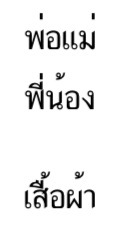
Nouns can occur together to make a new one where the second noun does not modify the first: |
|
|
three children |

NOUN + CARDINAL NUMBER + CLASSIFIER
|
|
|
a child (undefined article) |

classifier before 1
|
|
|
some ‘farangs’ (Westerners) |

NOUN + QUANTIFIER + CLASSIFIER |
|
|
every kind of fish |

NOUN + QUANTIFIER + CLASSIFIER |
|
|
not many letters |

NOUN + QUANTIFIER + CLASSIFIER |
|
|
the third child |
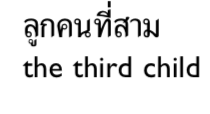
NOUN + CLASSIFIER + ORDINAL NUMBER |
|
|
the first book |

NOUN + CLASSIFIER + ORDINAL NUMBER |
|
|
which book? |

NOUN + CLASSIFIER + DEMONSTRATIVE |
|
|
that house over there |

NOUN + CLASSIFIER + DEMONSTRATIVE |
|
|
When a noun can be omitted in constructions like NOUN + CLASSIFIER + DEMONSTRATIVE |
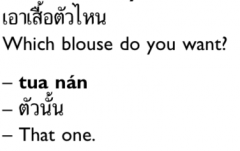
when the noun is clear |
|
|
When a classifier can be omitted in constructions like NOUN + CLASSIFIER + DEMONSTRATIVE (e.g., That blouse isn’t pretty. ) |

in spoken Thai |
|
|
those two blouses |

NOUN + CARDINAL NUMBER + CLASSIFIER + DEMONSTRATIVE |
|
|
an old book |

NOUN + ADJECTIVE |
|
|
that big house |

NOUN + ADJECTIVE + CLASSIFIER + DEMONSTRATIVE |
|
|
(these) two old books |

NOUN + ADJECTIVE + CARDINAL NUMBER + CLASSIFIER (+ DEMONSTRATIVE) |
|
|
the second old book |

NOUN + ADJECTIVE + CLASSIFIER + ORDINAL NUMBER |
|
|
the new shirt (pattern to distinguish the noun referred to from other members of the same class) |

NOUN + CLASSIFIER + ADJECTIVE |
|
|
a high-ranking civil servant |

NOUN + NOUN Some nouns can be used adjectivally to modify the preceding noun:
|
|
|
my house |

NOUN + (khoong) + POSSESSOR khoong is optional and is very frequently omitted
|
|
|
all of them |

|
|

обращение |
1. friend or colleague 2. wives addressing their husbands 3. service-industry workers addressing customers 4. complete strangers striking up a conversation with someone older
|
|
|
Are you (addressing Suwannee) free? (personal pronoun) |

|
|
|
I (monk speaking) |

|
|
|
you (monk speaking) |

|
|
|
reflexive pronoun (typical), e.g. to sell oneself |
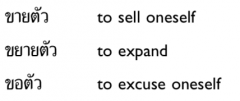
tua (‘body’) is used with first, second and third persons |
|
|
reflexive pronoun (smaller category of verbs) |

|
|
|
The idea of doing something ‘by oneself’, e.g. We did it by ourselves. |

|
|
|
emphatic pronoun: I myself did it. |

(tua) PERSONAL PRONOUN + eeng + VERB |
|
|
emphatic pronoun: I did it myself. |

PERSONAL PRONOUN + VERB + eeng |
|
|
emphatic pronoun: I myself was the one who did it. |

PERSONAL PRONOUN + eeng + pen khon + VERB |
|
|
the sense of ‘the very same (one) : this very friend |

eeng occurs after demonstratives |
|
|
Reciprocal: ‘each other’: We must help one another. |

SUBJECT + VERB (PHRASE) + kan (‘together’) |
|
|
Possessive pronouns: Yours is pretty. |

khoong (‘of’) + PERSONAL PRONOUN: |
|
|
Indefinite pronouns: something, somebody, somewhere |
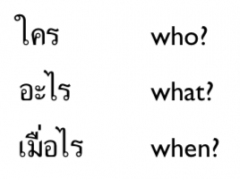
= Interrogative pronouns
|
|
|
go somewhere |

when thiinay immediately follows the verb pay (‘to go’) thîi is frequently dropped
|
|
|
I’ll buy whichever one is not expensive. |

naˇy as an indefinite pronoun means ‘whichever one’; it always follows a classifier and normally occurs with ko dâay
|
|
|
However I do it, I always make a mistake. |

yangngay as an indefinite pronoun means ‘however’, ‘whatever way’; it always follows a verb:
|
|
|
expressions ‘whoever/whenever/whatever you like’: Buy whichever one you like, We’ll meet whenever you like, You can give however much you like. |

Indefinite pronouns occur before ko dâay
|
|
|
Relative pronouns: The house where they live is small. |

A single relative pronoun thîi is used to refer to people, places and things |
|
|
формальная замена thîi в relative pronouns |

sueng can be used interchangeably with thîi but it is a rather formal-sounding word and much less common in spoken Thai
|
|
|
relative pronoun: formal, stylised linking of noun and adjective (or stative verb) |

an also functions rather like a relative pronoun
|
|
|
изменяются ли глаголы по временам |
нет. Thus pay can mean ‘go’, ‘went’, ‘will go’ |
|
|
The verb ‘to be’ |
pen, khue, mii and yùu |
|

pen (to be)
|

- always followed by a noun or noun phrase - the negative form ‘is not’ is either mây chây or mây dây pen;
|
|

khue (to be): three plus four is seven |

- means ‘is equal to’ or ‘namely’ and it is used when giving explanations, clarifications and definitions - also used as a hesitation device - does not occur in the negative
|
|
|
‘it’s not ..., it’s ...’ : She is not his girlfriend. She is his younger sister. |

mây chây ..., pen ... |
|
|
mii (to be): There are few Thais who can speak French well. |

- used to translate (there is, there are) - often especially in written Thai, it occurs after the topic
|
|
|
yùu (to be) |

yùu (‘to be situated at’) is used to describe the location of things |
|
|
verb compounds |

(a) VERB + NOUN; (b) NOUN + VERB; (c) VERB + VERB |
|
|
negate verb compound |

Verb compounds are negated by the pattern mây + VERB COMPOUND |
|
|
отличия resultative verbs от verb compound |
They differ in that the second verb describes a state that results from the action of the first verb; thus, sleep results from lying down and seeing from looking. |
|
|
negate resultative verbs |

VERB (PHRASE) + mây + RESULTATIVE VERB
|
|
|
что такое directional verbs (примеры) |

The verbs pay (‘to go’) and maa (‘to come’) are used after a number of verbs or verb phrases as ‘direction markers’ to indicate whether the action of the verb is directed towards or away from the speaker. Other common directional verbs are khuun (‘to rise’), long (‘to descend’), 2 khâw (‘to enter’) and ook (‘to leave’). |
|
|
перевод directional verb: I’ll ring you back in the evening |

|
|
|
I walked back and forth for ten minutes. |

pay and maa sometimes occur in the pattern VERB + pay + VERB + maa, where the same verb is repeated, to convey the idea of the action occurring repetitively back and forth: |
|
|
scheme of modal verbs of possibility and probability: He probably won't come |

MODAL VERB (+ ca) (+mây) + VERB (PHRASE) |
|
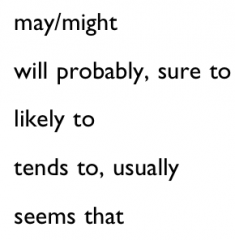
modal verbs of possibility and probability |
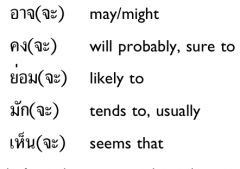
|
|
|
scheme of modal verbs of ability and permission: I can’t help her. |

VERB (PHRASE) (+mây) + MODAL VERB |
|
|
modal verb of both ability and permission: Can I borrow your car? |

VERB (PHRASE) + dâay |
|
|
modal verb of the sense of knowing how to do something: I can’t cook. |

VERB (PHRASE) + pen |
|
|
modal verb of the sense of being physically able to do something: Be careful, it’s heavy. Can you lift it? |

|
|
|
must, need, necessary to |

и tong |
|
|
negate modal verbs of necessity: It’s not necessary. |

mây + MODAL VERB + VERB (PHRASE) |
|
|
must not...: We must not forget. |

|
|
|
modal verbs of obligation: You should’ve told me in advance. |

1. Obligation is expressed by: khuan (ca) (‘should/ought’) or nâa (ca) (‘should/ought’) before the main verb. 2. Both are most commonly negated by the pattern mây + MODAL VERB (+ ca) + VERB (PHRASE) |
|
|
‘want to’ : She doesn’t want to talk to me. |

mây + yàak (ca) + VERB (PHRASE) |
|
|
Future actions: Tomorrow he won't come |

ca + VERB (PHRASE) |
|
|
Completed actions: He has gone to work. |

VERB (PHRASE) + leew (‘already’) |
|
|
Attained state: That’s correct. |

Attained states: STATIVE VERB + leew
|
|
|
Continuous action: I am/was reading |

Continuous actions, whether in the present or past, the pattern kamlang + VERB (PHRASE) + yùu (either yùu or kamlang may be dropped) |
|
|
Actions about to happen: I am/was about to go. |

kamlang ca + VERB (PHRASE) |
|
|
Actions that have just happened: I have just seen him. |

phueng + VERB (PHRASE) |
|
|
Single and habitual actions in the past: I’ve never seen it before. |

1. kheey + VERB (PHRASE) 2. it can occur with leew for added emphasis 3. When preceded by the negative word mây it means ‘never’ and often occurs in the pattern mây kheey . . . maa koon (‘never . . . before’) |
|
|
Negative past tense: I didn’t tell him. |

1. mây dây + VERB (PHRASE) 2. it cannot be used with stative verb |
|
|
past continuous tense: He has been studying Thai for many years. |

VERB (PHRASE) + maa + (dâay) +TIME EXPRESSION + leew |
|
|
Changed states: to worsen, to decrease |
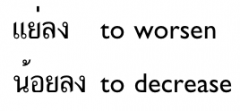
STATIVE VERB + khuen/long
|
|
|
action for future: He bought it to read another day. |

VERB (PHRASE) + wáy |
|
|
idea that the subject is doing something for himself: I’ve prepared things. |

VERB (PHRASE) + aw. Often aw is followed by wáy. |
|
|
Sense of ‘too bad it happened that way’: He came too late. |

One sense of sıˇa/sá is ‘too bad it happened that way’ |
|
|
irritation or impatience that something has not happened: When will it stop raining? |

muearày ca + VERB (PHRASE) + sá thii |
|
|
Passives: I’ve been bitten by a mosquito. |

1. much less commonly in Thai than in English 2. restricted to sentences with a negative connotation, where the subject is a victim of something unpleasant, 3. SUBJECT + thùuk + (AGENT) + VERB (PHRASE)
|
|
|
Much less common than thùuk, but used identically is the passive-marker: He was beaten |

doon |
|
|
English passive sentences that carry a neutral or positive connotation can often be rendered by the pattern? We were invited to . . . |

SUBJECT + dây ráp (‘received’) + VERB (PHRASE)
|
|
|
Passive using NOUN: He was educated in America. |

SUBJECT + dây ráp + NOUN |
|
|
English passive expressions like ‘it is well known that . . .’, ‘it is generally accepted that . . .’ |

pen thîi + VERB+kan+wâa
|
|
|
Verbs of utterance, mental activity and perception: I hope (that) it’s not too spicy |

Verbs of utterance (‘say, whisper, call’, etc.), mental activity (‘think, remember, hope’, etc.) and perception (‘see, understand, know’, etc.) are followed by wâa + SUBORDINATE CLAUSE
|
|
|
Verbs of emotion: I’m sorry (that) I didn’t go. |

Verbs of emotion (‘to be angry, sorry, excited’, etc.) are generally followed by thîi + SUBORDINATE CLAUSE |
|
|
Casuative: express unintended causation : She dropped the cup |

SUBJECT (human or non-human) + tham + (inanimate OBJECT) + VERB
|
|
|
Casuative: ‘to let someone do something’ or ‘to make someone do something’: They got me to come back next month |

SUBJECT (human) + hây + (animate OBJECT) + VERB (PHRASE) |
|
|
Casuative: specifying the method of causing someone to do something (e.g. by requesting, telling, ordering, etc.): We want you to come back soon |

SUBJECT (human)+SPECIFYING VERB+hây+(animate OBJECT) + VERB (PHRASE) |
|
|
Casuative: a sense of clear intention, co-ercion or non-accidental causation by the subject: Warm weather makes her feel good. |

SUBJECT (human or non-human) + tham hây + (OBJECT) + VERB (PHRASE) |
|
|
‘To give’: I gave him three books. |

- SUBJECT + hây + DIRECT OBJECT (+ kae) + INDIRECT OBJECT - The preposition kae (‘to, for’) is frequently omitted - quantifier follows the indirect object |
|
|
‘To give’: qualifier: I gave him books which I like. |

- the qualifier follows the direct object - but the preposition kae becomes obligatory
|
|
|
for someone: She passed me the letter. |

VERB + DIRECT OBJECT + hây + INDIRECT OBJECT |
|
|
Verb serialization: He went out to buy something and brought it back to eat. |

- a sequence of consecutive actions - a number of simultaneous actions |
|
|
noun is modified by two adjectives: the large, red book |

NOUN+ADJECTIVE+CLASSIFIER+ADJECTIVE |
|
|
suffixes of compound adjectives |
cay (‘heart’) nâa (‘worthy of’) khîi (‘having the characteristic of’) châng (‘given to/good at’) huˇa (‘head’) |
|
|
modifications of adjectives: My language isn’t good enough. |

- usually ADJECTIVE + MODIFIER - a few MODIFIER + ADJECTIVE (напр. mây) |
|
|
Special intensifiers: expensive |

Certain adjectives are followed by specific intensifiers can be translated as ‘very’ |
|
|
simple repetition of adjectives |
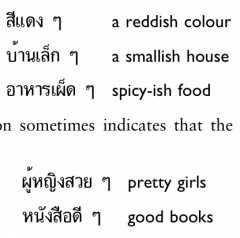
- makes the meaning less precise, corresponding approximately to the adjectival suffix -ish in English - sometimes indicates that the preceding noun is plural |
|
|
Repetition of adjective with tonal change: Ever so tasty! |

The meaning of an adjective is intensified by reduplication when the first element is pronounced with an exaggerated high tone, regardless of the normal tone of the word |
|
|
Comparison of adjectives: The air fare is more expensive than the last year |

ADJECTIVE + kwàa (‘more than’) |
|
|
Degrees of comparison: twise as expensive |

ADJECTIVE + kwàa, can be modified by the addition of degree adverbs, such as mâak (‘much, a lot’), yae(‘much, a lot’), nítnooy (‘a little’) |
|
|
equal comparison (standard): - Nakhorn Phanom is as far as Nongkhai. - Father and son are as tall as each other. |

- X + ADJECTIVE + thâw kàp (‘as much as’) + Y - X + kàp (‘with’) + Y + ADJECTIVE + thâw (thâw) kan/ phoo(phoo) kan (‘equally’) |
|
|
equal comparison (only for non-quantifiable adjectives): Chinese food is as tasty as Thai food. |

X + ADJECTIVE + muenkan (‘similar’) + Y |
|
|
equal comparison (not loose to):The daughter has as sharp a tongue as her mother. |

X + ADJECTIVE + mây phae(‘not lose to’) + Y |
|
|
Interrogative comparisons: Which book is cheaper? |

QUESTION WORD + ADJECTIVE + kwàa kan? |
|
|
Basic negative comparisons: Western food isn’t as good as/can’t beat Thai food. |

X + sûu + Y + mây dâay (‘X can’t beat Y’)
|
|
|
Specific negative comparisons using adjectives: Western food is not as spicy as Thai food |
specific negative comparisons using adjectives are often reversed to produce a positive comparison: Thai food is spicier than Western food |
|
|
Excessives ("too ..."): The shoes are too tight. |

- ADJECTIVE+(keen) pay (‘too much’) - keen frequently omitted, especially in spoken Thai
|
|
|
Excessives ("too ...") with the additions of the degree adverbs: a little bit too late |

degree adverbs nooy (‘a little’), nítnooy‚ (‘a little bit’) or mâak (‘a lot’) can be added |
|
|
Superlatives: The most important thing is ... |

ADJECTIVE + thîi sùt ("most")
|
|
|
Is there any difference between adverbs of manner and adjectives? |
No. Thus dii means both ‘good’ and ‘well’ and cháa both ‘slow’ and ‘slowly |
|
|
Adverb construction options |
1. VERB (PHRASE) + ADJECTIVE 2. VERB (PHRASE) + REDUPLICATED ADJECTIVE 3. VERB (PHRASE) + dây + ADJECTIVE 4. VERB (PHRASE) + hây + ADJECTIVE ----- 5. VERB (PHRASE) + ADVERBIAL PHRASE
|
|
|
Adverb: He walks slowly |

VERB (PHRASE) + ADJECTIVE |
|
|
Adverb: He walks slow(ish)ly |

VERB (PHRASE) + REDUPLICATED ADJECTIVE |
|
|
Adverbs in commands: Speak up! |

- Reduplication is commonly used in commands - Commands can be made more polite by the addition of nooy at the end
|
|
|
Adverbs: VERB (PHRASE) + ADVERBIAL PHRASE |
- yàang is followed by a verb or verb phrase - dooy by a verb or noun phrase - dûay and pen by a noun phrase |
|
|
Adverbs: yàang: She smiled happily. |

VERB (PHRASE) + yàang + VERB (PHRASE) |
|
|
Adverbs: dooy: He spoke without thinking. |

VERB (PHRASE) + dooy + VERB PHRASE |
|
|
Adverbs: duay: He worked with difficulty |

VERB (PHRASE) + duay + NOUN PHRASE |
|
|
Adverbs: pen: She divided it into small pieces |

VERB (PHRASE) + pen + NOUN PHRASE |
|
|
Adverbs: When describing how well someone can do something: He speaks fluently |

VERB (PHRASE) + dâay + ADJECTIVE |
|
|
Adverbs: When giving commands as to how someone should do something: Dress respectably! |

VERB (PHRASE) + hây + ADJECTIVE |
|
|
Modification of adverbs: He doesn’t speak very clearly. |

- usually: ADVERB + MODIFIER - a few: MODIFIER + ADVERB (напр. mây или mây khooy )
|
|
|
Comparison of adverbs (all patterns): You are a better cook than me. (you – make food – more tasty than – me) |

The same as for adjectives, but with VERB (PHRASE) before the adjective. |
|
|
The ‘as . . . as possible’ construction (with repetition): He ran as quickly as possible. |

VERB (PHRASE) + yàang + ADJECTIVE + thîi sùt + (thâw) thîi ca + ADJECTIVE + dâay |
|
|
The ‘as . . . as possible’ construction (with tham ): I shall do it as well as possible. |

VERB (PHRASE) + yàang + ADJECTIVE + thîi sùt + (thâw) thîi ca + tham + dâay |
|
|
Position of yang (‘still’) in a sentence: I’m still hungry. |

Just before the verb |
|
|
Position of leew (‘already’) in a sentence: He’s already gone. |

Right after the verb |
|
|
Position of adverbs of time in the sentence: Before, I did not like it. |

adverbial phrases can occur either before or after the verb phrase |
|
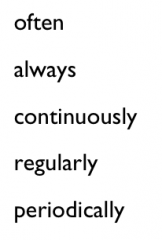
Location and translation of the following adverbs of frequency |
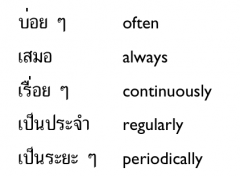
only after a verb or verb phrase |
|
|
Location of the words thammadaa (‘normally, usually’) and pòkkati (‘normally, usually’) |
At the beginning of the sentence |
|
|
Location of baang khráng (‘sometimes’), thúk wan (‘daily’), aathít la soon khráng (‘twice a week’): Sometimes I feel bored. |

- before the subject of a sentence - at the end of a sentence: |
|
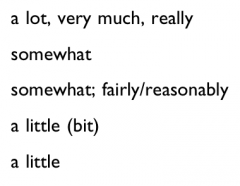
Location and translation of the following adverbs of degree |
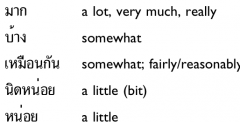
only after a verb or verb phrase: |
|
|
polite agreement (when a negative response would be tactless): Is he a good teacher? Well ... yes. |
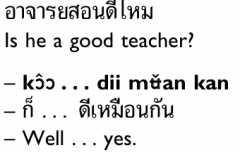
|
|
|
Difference between the adverb bâang and the similar-sounding baang: I can play a bit/somewhat. |

1. As a quantifier, baang (‘some’) is always followed by a classifier 2. bâang normally modifies a verb and conveys the sense of ‘to some extent’ or ‘somewhat’ 3. bâang also occurs with Wh- questions, where it anticipates a plural answer 4. bâang never occurs with classifiers
|
|
|
simple sentence stating the location of something: The house is over there. |

thîi follows the verb yùu (‘to be situated at’) |
|
|
Is thîi is optional after the verb yùu? : He is at home in the evenings. |

thîi is optional after the verb yùu, and frequently omitted: |
|
|
When is it necessary to add khâng before prepositions of place: It’s behind the house. |

- when a noun or noun phrase follows the preposition, khâng is usually dropped - if no noun follows the preposition, khâng cannot be dropped |
|
|
Which prepositions of place phaay can be used with? |
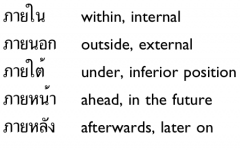
|
|
|
When is the prefix thaang (‘way’) used? |

- prefixes the words for sáay (‘left’) and khwaˇa (‘right’) when describing locations - mue(‘hand’) may optionally be added to the end of the phrase |
|
|
Which prepositions are non-prefixed? |
between, far, near, opposite, on the edge of, along |
|
|
‘To’: He gave the book to me. |

- no preposition - "speak to" uses the preposition kàp (‘with’) |
|
|
Options for "For" |
hây, phuea , saˇmràp and sùan |
|
|
"For" hây: Please shut the door for me. |

hây is used to express the idea of - doing something for somebody - getting someone to do something for you |
|
|
"For" phuea: I am working for our future. |

phuea can be translated as ‘for the sake of’ and often conveys an idea of altruism |
|
|
"For" saˇ mràp: This is for you. |

- ‘for’ - at the beginning of a sentence, ‘as for’ |
|
|
"For" sùan |

sùan means ‘as for’ and is used to introduce a statement |
|
|
"For" duration: We are only going for two days. |

No preposition |
|
|
"For" reason (I'm angry for...): I am sorry that I’m late. |

reason clauses are introduced by thîi |
|
|
Travelling somewhere as a passenger in a vehicle: I went to Chiangmai by bus. |

nâng (‘to sit’) + VEHICLE + pay/maa + PLACE |
|
|
"By" method: How did you do it? (you – do – by – method – which?) |

dooy and duay |
|
|
Travelling somewhere and driving something: We went to Hua Hin by motorcycle |

VERB + VEHICLE + pay/maa + PLACE: ‘to drive’ – khàp (for cars), khìi (for motorcycles, horses, bicycles) or thìip (for pedal trishaws) |
|
|
"By" place: It is by the TV |

klây klây (‘near’) or khâng khâang (‘next to, beside’); |
|
|
"By" time: I have to finish it by Friday. |

koon (‘before’) or phaay nay (‘within’)
|
|
|
‘With’ accompaniment: I went with a friend |

Accompaniment, in Thai, is conveyed by kàp: |
|
|
'With' instrument: She hit her husband with a stick |

SUBJECT+cháy (to use) + INSTRUMENT + VERB (PHRASE) |
|
|
'With' intrument: ‘to see with one’s own eyes’ and ‘to hear with one’s own ears’ |
heˇn kàp taa (‘to see with one’s own eyes’) and fang kàp huˇu (‘to hear with one’s own ears’). |
|
|
‘From’: I got a letter from my mother. |

caak |
|
|
'since ... till ...': from morning till evening |

tângtae + TIME WORD + thueng (‘till’) + TIME WORD |
|
|
'since ...': from that day |
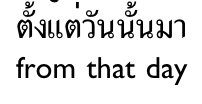
tângtae + TIME WORD + maa |
|
|
noun-pronoun apposition: Father bought a car. |

|
|
|
Omit as many words as can: I must rush off and buy some for her. |

|
|
|
topicalisation: As for the food and accommodation, it was alright. |

1. placing a word or phrase other than the subject at the beginning of the sentence 2. In spoken Thai, the particle nâ/nâa is often used at the end of the topic phrase 3. In written Thai, the topic is often introduced by sùan (‘as for’), saˇmràp (‘as for’) or rueng (‘about, concerning’) 4. the end of a long topic clause is often marked by nán and the verb in the following clause introduced by ko (‘so, therefore, well, then’)
|
|
|
Conditional clauses: ‘if’: If it rains, I’m not going |

- pattern: thâa . . . ko + VERB - alternative words for ‘if’ are thâa hàak wâa, hàak wâa, hàak tea wâa |
|
|
What can be omitted in conditional clause "if": If it rains, I’m not going |

1. ‘if’ word is omitted 2. and in abrupt speech, even ko |
|
|
Conditional clauses: ‘if’: alternative link words between the cause and the main phrase: If you don't hurry, you won't be on time. |

- lá ko (or lá koo, with a lengthened vowel on the second syllable) - in which case the verb normally follows |
|
|
Reason clauses: The fact that he won’t agree to fly is because he is scared. |

kaan thîi ... ko+phro wâa ... (‘The fact that ... is because . . .’) |
|
|
Reason clauses: Because it was raining heavily, we were a bit late. |

kaan thîi . . . ko + VERB (‘Because . . . so . . .’) |
|
|
Reason clauses: what can be omitted? The fact that I spoke like that was because I was angry. |

kaan to be dropped and the sentence to begin with thîi: |
|
|
Reason clauses: Due to the heavy traffic jams, he will probably be late. |

nueang càak . . . ko + VERB (Due to . . . so . . .’) |
|
|
Reason clauses: What is commonly used instead of ko in written Thai? Because there is still no news, it is therefore impossible to say. |

In written Thai cueng is commonly used instead of ko
|
|
|
Concessive clauses: ‘although’: Although I love her, she doesn’t love me. |

1. Concessive clauses begin with either (thueng) mae wâa (‘although’) or tháng tháng thîi (‘although’) 2. The main clause begins with tae (ko) (‘but’) |
|
|
Concessive clauses: ‘regardless’: Regardless of how expensive it was, I still think it was worth it. |

mây wâa ca (‘regardless, no matter’) + VERB + QUESTION WORD; the main clause may be introduced by ko |
|
|
Purpose clauses: ‘in order to’: I did that in order to help a friend. |

Purpose clauses often begin with phuea (thîi) ca (‘in order to’) |
|
|
Additive clauses: ‘apart from’: Apart from Chiangmai, we went to Lampang, too. |

giving additional information is nook càak . . . leew ... yang ... (dûay) (‘apart from ... still ... (too)’) |
|
|
Time clauses: no sooner... than ... : No sooner does he sit down in front of the TV than he falls asleep. |

1. phoo ... púp (ko) ... 2. ... púp .... páp |
|
|
Time clauses: when (past) ... and when ... : When I was a student, I smoked a lot. |

1. muea ... (ko) ... 2. weelaa ... (ko) ... |
|
|
Time clauses: before ...: Before withdrawing the money, I’ll have to discuss it with my husband |

Before koon thîi . . . (ko ) . . . .
|
|
|
Time clauses: while ... : While I was chatting on the phone, someone called me. |

1. khanà thîi ... (ko) ... 2. toon thîi ... (ko) ... 3. nay rawàang thîi . . . (ko) . . . |
|
|
Direct and indirect speech: He said, ‘I’m not going.’ |

Both direct and indirect speech are introduced by wâa |
|
|
Imperatives: Look! |

A simple verb or verb phrase softened by adding the mild command particle sí or theu‚ at the end of the sentence |
|
|
First person imperatives (‘Let’s . . .’): Let’s go and eat out! |

VERB (PHRASE) +theu |
|
|
Imperative (written instructions): Answer the (following) questions. |

cong is an imperative which appears in written instructions |
|
|
Exemplification: I have to do lots of things, such as washing, cooking and cutting the grass. |

1. chên . . . pen tôn (‘for example, . . .’) 2. either chên or pen tôn may be omitted
|
|
|
Exemplification: ‘To give an example’: Let me give an example. |

‘To give an example’ is yók (‘to raise’) tua yàang (‘example’): |
|

|
1. Used by male speakers only 2. it is not used in isolation with the negative mây 3. Often used humorously as a sign of exaggerated deference or politeness |
|

|
1. Used by female speakers only 2. Used after a name to attract the person’s attention 3. Can also be used in isolation as a response when one’s name is called |
|

|
1. Used as an informal substitute for khráp or khá 2. male pronunciation is characterised by a distinctive final glottal stop not associated with female usage. |
|

|
1. Used by adult male and female speakers 2. when speaking to children, servants and people of inferior status; 3. between males and females denotes anything from easy familiarity to ‘sweettalk’ 4. between females signals ‘best friends talk’ 5. used as a response when one’s name is called (when the vowel is often lengthened to câa) 6. used in isolation as a ‘yes’ response 7. used after mây to 2 mean ‘no’. |
|

|
An impolite or informal particle, used to indicate rudeness, anger and aggressiveness when speaking to strangers intimacy with close friends of equal status |
|

|
An impolite or informal particle, similar to wá/wâ, but restricted in usage to female speakers. |
|

Mood particle: Can I have the bill, please? |

Typically used in polite requests, apologies and cries for help |
|

Mood particle |

1. A contracted form of leaw (‘already’), one use of lá is to indicate that a state has been reached 2. It can also be used to indicate that a situation is about to change 3. Another use is with ìik (‘again’) to show mild irritation |
|

Mood particle |
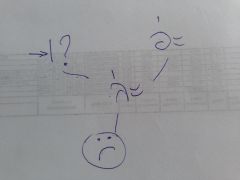
1. occurs commonly in questions, as a way of pressing for an answer 2. In thammay lâ? and pay naˇy lâ? to hear lâ reduced to â 3. Sometimes the particle conveys a sense of irritation, similar to English ‘why on earth . . .?’ |
|
|
Pattern "And how about . . .?": And how about you? |

pattern laew . . . lâ (‘And how about . . .?, What about . . .?’) to change the focus or topic of conversation
|
|

|
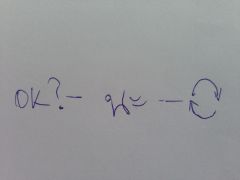
1. to make a sentence milder or less abrupt by seeking approval, agreement or compromise. ná often corresponds to the use of ‘. . ., OK?’ (pay lá ná - I’m going now, OK? ) 2. ná is also used when requesting someone to repeat a piece of information, similar to English ‘What was that again?’ |
|

|
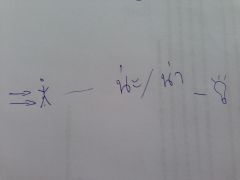
1. Is used when persuading somebody to do something when they are reluctant (cf. Come on, . . .): yàa pay nâa Oh, come on, don’t go. 2. It is also used to highlight the topic of a sentence, in much the same way that some speakers of English use ‘right’. Women, right, are like that. |
|

|
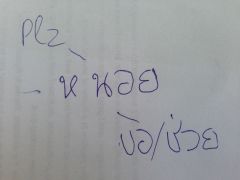
1. Polite request particle, basically meaning ‘just a little’ 2. commonly occurs in requests that begin with khoo or chûay
|
|

|
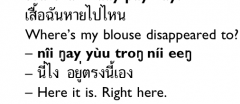
Used as a response to show that the respondent thinks the answer is self-evident |
|

|
1. Occurs most commonly at the end of negative statements to contradict the statement or belief 2. In positive statements it can convey a qualified or somewhat hesitant acceptance of the addressee’s statement or belief (koo cing look - That’s true (but . . .) 3. It can also be used to express sarcasm or mild annoyance |
|
|
Express mild annoyance: I can speak for myself. |

|
|

Usage |

1. In commands 2. to emphasise a positive response to a question 3. to contradict negative statements |
|

Difference between short and long form |

- When pronounced with a short vowel and followed by a polite particle it is widely used in polite requests (‘Do sit down, please’); - More insistent requests and commands are conveyed when the particle is pronounced with a falling tone and longer vowel (‘Sit down!’)
|
|
|
contradict negative statements: - He probably won’t come. – Oh yes, he will! |
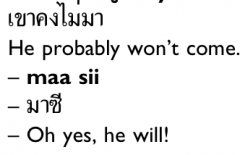
|
|

|

1. A mild, ‘urging’ particle, used in suggestions, invitations, requests and mild commands; can often be conveyed in English by "you’d/we’d better" 2. when joint activity is being suggested, it is often preceded by kan (‘together’); 3. often reduced to hae in informal speech.  |
|
|
Pattern "you’d/we’d better ...": You'd better go home. It is late. |

|
|

|

- Polite request particle, basically meaning ‘just this once’ - similar in function to nooy‚ but much more restricted in use |
|
|
Negative words |
1. mây (‘not, no’), widely used in negative sentences and negative responses to questions; 2. mí, a variant of mây; 4. hâam (‘to forbid’), both used in negative commands and prohibitions; 5. plàaw (‘no’), a negative response which contradicts the assumption in the question; 6. yang (‘not yet’), used 6 only as a negative response to . . . rueyang? questions |
|
|
Negating resultative verbs: I haven’t yet finished watching the film. |

The word yang can be added, either immediately before mây, or immediately before the main verb, to convey the sense that the action has not yet produced the intended result: |
|
|
Time clauses: after ... |

laˇng càak thîi ... (ko) ... |
|
|
Which auxiliary verbs are negated using: mây + AUXILIARY VERB + VERB (PHRASE) |

|
|
|
Which auxiliary verbs are negated using: AUXILIARY VERB + mây + VERB (PHRASE) |
ca, àat (ca), khong (ca), mák (ca), yoom(ca), heˇn ca, theap(ca), thâa ca, duu muean (ca), tong |
|
|
Negating auxiliary verbs: You must not tell him. |

|
|
|
Negating auxiliary verbs: You probably won’t be interested |

|
|
|
Negating auxiliary verbs: You don’t have to tell him/There’s no need to tell him. |

|
|
|
Negating auxiliary verbs: We don’t want to go home. |

|
|
|
Which auxiliary verbs are negated using: VERB (PHRASE) + mây + AUXILIARY VERB |
This pattern occurs with the modal verbs expressing ability and permission, pen, dâay and waˇy |
|
|
Usage of mây dây + VERB (PHRASE) |

1. To form a negative past with verbs of motion, action, utterance, etc: My friend didn’t come. 2. To contradict an assumption. 3. To negate the verbs chue (‘to be named’) and pen (‘to be’) |
|
|
This isn't his house |

mây chây + NOUN |
|
|
It's neither ..., nor ...: It's neither vegetable, nor fruit. |

NOUN 1 + kO mây chây + NOUN 2 + kO mây cheang: |
|
|
mây mii |
1. mây mii (‘there are not’) is placed before a noun to form the negative quantifier ‘not any’ and ‘no’ 2. mây mii is also used to negate the indefinite pronouns khray (‘anyone’) aray (‘anything’) and thîi naˇy (‘anywhere’) |
|
|
There’s nowhere suitable. |

|
|
|
Negative intensifiers |

|
|
|
‘not ..., not even a single ...’ : I don’t know even a single person. |

mây . . . mae tae‚ + CLASSIFIER + diaw |
|
|
Negative softeners |

|
|
|
Negative softeners: The film wasn’t much fun. |

mây khooy also commonly occurs without thâwrày or nák |
|
|
Negative imperatives: Don’t ever, under any circumstances, ring me again. |

1. Negative commands follow the pattern, yàa (‘Don’t’) + VERB (PHRASE), or hâam (‘It’s forbidden to . . .’) + VERB (PHRASE); 2. both can be made more emphatic by adding pen an khàat or dèt khàat |
|
|
The sense that it is the wrong time for doing something: Don’t tell him just yet, OK? |
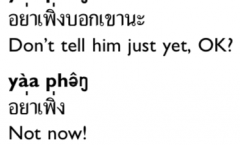
yàa pheang + VERB (PHRASE) |

